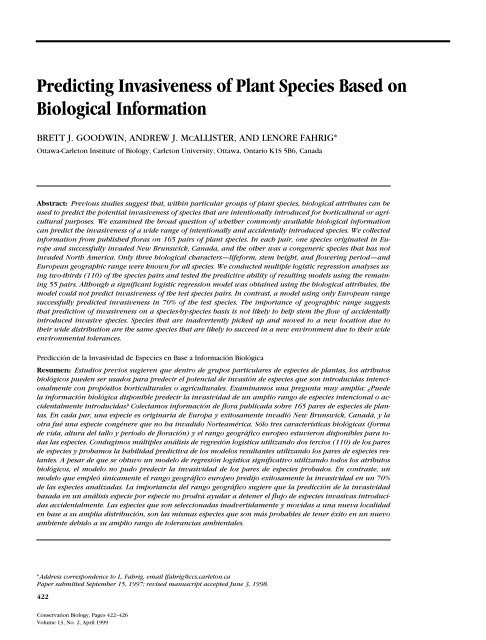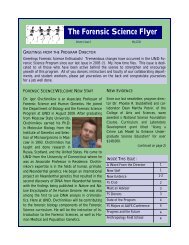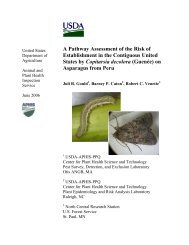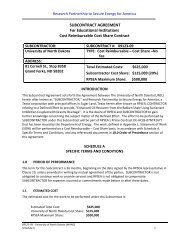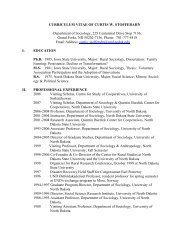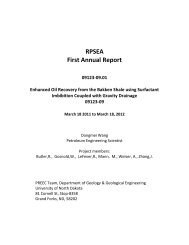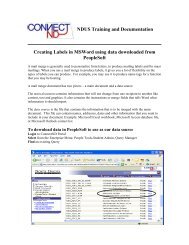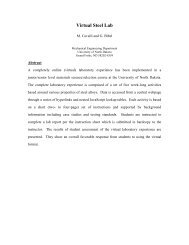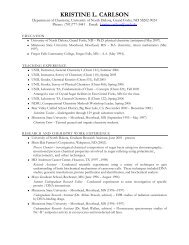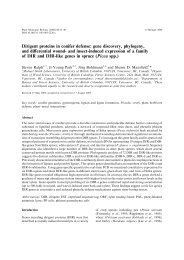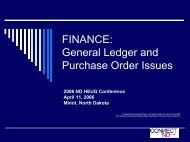Predicting Invasiveness of Plant Species Based on Biological ...
Predicting Invasiveness of Plant Species Based on Biological ...
Predicting Invasiveness of Plant Species Based on Biological ...
You also want an ePaper? Increase the reach of your titles
YUMPU automatically turns print PDFs into web optimized ePapers that Google loves.
<str<strong>on</strong>g>Predicting</str<strong>on</strong>g> <str<strong>on</strong>g>Invasiveness</str<strong>on</strong>g> <str<strong>on</strong>g>of</str<strong>on</strong>g> <str<strong>on</strong>g>Plant</str<strong>on</strong>g> <str<strong>on</strong>g>Species</str<strong>on</strong>g> <str<strong>on</strong>g>Based</str<strong>on</strong>g> <strong>on</strong><br />
<strong>Biological</strong> Informati<strong>on</strong><br />
BRETT J. GOODWIN, ANDREW J. MCALLISTER, AND LENORE FAHRIG*<br />
Ottawa-Carlet<strong>on</strong> Institute <str<strong>on</strong>g>of</str<strong>on</strong>g> Biology, Carlet<strong>on</strong> University, Ottawa, Ontario K1S 5B6, Canada<br />
Abstract: Previous studies suggest that, within particular groups <str<strong>on</strong>g>of</str<strong>on</strong>g> plant species, biological attributes can be<br />
used to predict the potential invasiveness <str<strong>on</strong>g>of</str<strong>on</strong>g> species that are intenti<strong>on</strong>ally introduced for horticultural or agricultural<br />
purposes. We examined the broad questi<strong>on</strong> <str<strong>on</strong>g>of</str<strong>on</strong>g> whether comm<strong>on</strong>ly available biological informati<strong>on</strong><br />
can predict the invasiveness <str<strong>on</strong>g>of</str<strong>on</strong>g> a wide range <str<strong>on</strong>g>of</str<strong>on</strong>g> intenti<strong>on</strong>ally and accidentally introduced species. We collected<br />
informati<strong>on</strong> from published floras <strong>on</strong> 165 pairs <str<strong>on</strong>g>of</str<strong>on</strong>g> plant species. In each pair, <strong>on</strong>e species originated in Europe<br />
and successfully invaded New Brunswick, Canada, and the other was a c<strong>on</strong>generic species that has not<br />
invaded North America. Only three biological characters—lifeform, stem height, and flowering period—and<br />
European geographic range were known for all species. We c<strong>on</strong>ducted multiple logistic regressi<strong>on</strong> analyses using<br />
two-thirds (110) <str<strong>on</strong>g>of</str<strong>on</strong>g> the species pairs and tested the predictive ability <str<strong>on</strong>g>of</str<strong>on</strong>g> resulting models using the remaining<br />
55 pairs. Although a significant logistic regressi<strong>on</strong> model was obtained using the biological attributes, the<br />
model could not predict invasiveness <str<strong>on</strong>g>of</str<strong>on</strong>g> the test species pairs. In c<strong>on</strong>trast, a model using <strong>on</strong>ly European range<br />
successfully predicted invasiveness in 70% <str<strong>on</strong>g>of</str<strong>on</strong>g> the test species. The importance <str<strong>on</strong>g>of</str<strong>on</strong>g> geographic range suggests<br />
that predicti<strong>on</strong> <str<strong>on</strong>g>of</str<strong>on</strong>g> invasiveness <strong>on</strong> a species-by-species basis is not likely to help stem the flow <str<strong>on</strong>g>of</str<strong>on</strong>g> accidentally<br />
introduced invasive species. <str<strong>on</strong>g>Species</str<strong>on</strong>g> that are inadvertently picked up and moved to a new locati<strong>on</strong> due to<br />
their wide distributi<strong>on</strong> are the same species that are likely to succeed in a new envir<strong>on</strong>ment due to their wide<br />
envir<strong>on</strong>mental tolerances.<br />
Predicción de la Invasividad de Especies en Base a Información Biológica<br />
Resumen: Estudios previos sugieren que dentro de grupos particulares de especies de plantas, los atributos<br />
biológicos pueden ser usados para predecir el potencial de invasión de especies que s<strong>on</strong> introducidas intenci<strong>on</strong>almente<br />
c<strong>on</strong> propósitos horticulturales o agriculturales. Examinamos una pregunta muy amplia: ¿Puede<br />
la información biológica disp<strong>on</strong>ible predecir la invasividad de un amplio rango de especies intenci<strong>on</strong>al o accidentalmente<br />
introducidas? Colectamos información de flora publicada sobre 165 pares de especies de plantas.<br />
En cada par, una especie es originaria de Europa y exitosamente invadió New Brunswick, Canadá, y la<br />
otra fué una especie c<strong>on</strong>génere que no ha invadido Norteamérica. Sólo tres características biológicas (forma<br />
de vida, altura del tallo y periodo de floración) y el rango geográfico europeo estuvier<strong>on</strong> disp<strong>on</strong>ibles para todas<br />
las especies. C<strong>on</strong>dugimos múltiples análisis de regresión logística utilizando dos tercios (110) de los pares<br />
de especies y probamos la habilidad predictiva de los modelos resultantes utilizando los pares de especies restantes.<br />
A pesar de que se obtuvo un modelo de regresión logística significativo utilizando todos los atributos<br />
biológicos, el modelo no pudo predecir la invasividad de los pares de especies probados. En c<strong>on</strong>traste, un<br />
modelo que empleó únicamente el rango geográfico europeo predijo exitosamente la invasividad en un 70%<br />
de las especies analizadas. La importancia del rango geográfico sugiere que la predicción de la invasividad<br />
basada en un análisis especie por especie no prodrá ayudar a detener el flujo de especies invasivas introducidas<br />
accidentalmente. Las especies que s<strong>on</strong> selecci<strong>on</strong>adas inadvertidamente y movidas a una nueva localidad<br />
en base a su amplia distribución, s<strong>on</strong> las mismas especies que s<strong>on</strong> más probables de tener éxito en un nuevo<br />
ambiente debido a su amplio rango de tolerancias ambientales.<br />
*Address corresp<strong>on</strong>dence to L. Fahrig, email lfahrig@ccs.carlet<strong>on</strong>.ca<br />
Paper submitted September 15, 1997; revised manuscript accepted June 3, 1998.<br />
422<br />
C<strong>on</strong>servati<strong>on</strong> Biology, Pages 422–426<br />
Volume 13, No. 2, April 1999
Goodwin et al. Invasive versus N<strong>on</strong>invasive <str<strong>on</strong>g>Plant</str<strong>on</strong>g>s 423<br />
Introducti<strong>on</strong><br />
Invasive species have become an increasingly important<br />
c<strong>on</strong>servati<strong>on</strong> issue (di Castri 1990). Invasive species enter<br />
various habitats (Baker 1986; Fox & Adams<strong>on</strong> 1986;<br />
Gray 1986; Mo<strong>on</strong>ey et al. 1986; Mack 1989) and may alter<br />
ecosystem properties and processes (Vitousek 1986;<br />
Le Maitre et al. 1996) as well as native community structure<br />
(Simberl<str<strong>on</strong>g>of</str<strong>on</strong>g>f 1981). An invasive plant may threaten<br />
the protected plant species in a reserve (Usher 1988;<br />
Macd<strong>on</strong>ald et al. 1989) or change habitat suitability for<br />
animals (Trammell & Butler 1995).<br />
Several authors have suggested that it is important to understand<br />
what biological characteristics make a species a<br />
good invader so that species that are likely to be invasive<br />
can be screened and the costs <str<strong>on</strong>g>of</str<strong>on</strong>g> invasi<strong>on</strong> can be reduced<br />
by preventing the initial introducti<strong>on</strong>s. Studies have c<strong>on</strong>sidered<br />
either a set <str<strong>on</strong>g>of</str<strong>on</strong>g> successfully invasive species (Newsome<br />
& Noble 1986; Reichard & Hamilt<strong>on</strong> 1997) or have<br />
compared species characteristics <str<strong>on</strong>g>of</str<strong>on</strong>g> native and invasive<br />
species (Baker 1965; Caldwell et al. 1981, 1983; Baruch et<br />
al. 1985; Roy 1990; Pys˘<br />
ek et al. 1995; Thomps<strong>on</strong> et al.<br />
1995). Characteristics identified as important determinants<br />
<str<strong>on</strong>g>of</str<strong>on</strong>g> invasiveness are small, short-lived seeds that can germinate<br />
without pretreatment (e.g., freezing), short juvenile<br />
periods and short intervals between large seed crops, large<br />
size, l<strong>on</strong>g flowering period, vegetative reproducti<strong>on</strong>, and<br />
perfect flowers (Crawley 1987, 1989; Perrins et al. 1992,<br />
Richards<strong>on</strong> et al. 1994; Thomps<strong>on</strong> et al. 1995, Rejmánek &<br />
Richards<strong>on</strong> 1996; Reichard & Hamilt<strong>on</strong> 1997).<br />
The usefulness <str<strong>on</strong>g>of</str<strong>on</strong>g> such characteristics for predicting<br />
which species will be invasive differs for intenti<strong>on</strong>al versus<br />
accidental introducti<strong>on</strong>s. In the case <str<strong>on</strong>g>of</str<strong>on</strong>g> plants that<br />
are intenti<strong>on</strong>ally introduced for horticultural or agricultural<br />
purposes, potential invasiveness can be assessed<br />
<strong>on</strong> a case-by-case basis when applicati<strong>on</strong> is made for importati<strong>on</strong><br />
<str<strong>on</strong>g>of</str<strong>on</strong>g> the plant. <strong>Biological</strong> attributes that predict<br />
invasiveness in such a group could be used to decide<br />
whether to grant a permit to introduce a species (e.g.,<br />
Reichard & Hamilt<strong>on</strong> 1997).<br />
If biological attributes <str<strong>on</strong>g>of</str<strong>on</strong>g> invasiveness apply to both intenti<strong>on</strong>ally<br />
and accidentally introduced species, then it<br />
should be possible to use this informati<strong>on</strong> to develop protocols<br />
for transportati<strong>on</strong> and shipping that will reduce the<br />
probability <str<strong>on</strong>g>of</str<strong>on</strong>g> accidental introducti<strong>on</strong>s <str<strong>on</strong>g>of</str<strong>on</strong>g> invasive species.<br />
A potential difficulty, however, is that many <str<strong>on</strong>g>of</str<strong>on</strong>g> the attributes<br />
used to predict invasiveness <str<strong>on</strong>g>of</str<strong>on</strong>g> intenti<strong>on</strong>ally introduced<br />
species are not available for the majority <str<strong>on</strong>g>of</str<strong>on</strong>g> species.<br />
To predict invasiveness <str<strong>on</strong>g>of</str<strong>on</strong>g> all potentially invasive species,<br />
both intenti<strong>on</strong>ally and accidentally introduced, we must<br />
limit the biological attributes to those that are available for<br />
most or all species. The first objective <str<strong>on</strong>g>of</str<strong>on</strong>g> this study therefore<br />
was to determine whether invasiveness can be predicted<br />
from comm<strong>on</strong>ly available biological informati<strong>on</strong>.<br />
In additi<strong>on</strong> to biological informati<strong>on</strong>, the geographical<br />
range <str<strong>on</strong>g>of</str<strong>on</strong>g> a species in its area <str<strong>on</strong>g>of</str<strong>on</strong>g> origin should be related to<br />
the probability <str<strong>on</strong>g>of</str<strong>on</strong>g> its moving and persisting elsewhere (invading)<br />
for two reas<strong>on</strong>s. First, wider-ranging species are<br />
more likely to come into c<strong>on</strong>tact and be carried with internati<strong>on</strong>al<br />
transport <str<strong>on</strong>g>of</str<strong>on</strong>g> goods. Sec<strong>on</strong>d, species with<br />
larger original ranges are more likely to be pre-adapted to<br />
c<strong>on</strong>diti<strong>on</strong>s in a new area (Groves 1986; Holdgate 1986;<br />
Roy 1990). Thus, our sec<strong>on</strong>d objective was to determine<br />
whether invasiveness can be predicted more successfully<br />
using biological attributes or geographic range.<br />
Methods<br />
We compared attributes <str<strong>on</strong>g>of</str<strong>on</strong>g> plant species that originated<br />
in Europe and have successfully invaded New Brunswick,<br />
Canada, to c<strong>on</strong>generic species in Europe that<br />
have not invaded North America. We included woody<br />
and herbaceous plants and species that were introduced<br />
intenti<strong>on</strong>ally and accidentally. We used c<strong>on</strong>generic pairs<br />
<str<strong>on</strong>g>of</str<strong>on</strong>g> species to minimize the potentially c<strong>on</strong>founding effects<br />
<str<strong>on</strong>g>of</str<strong>on</strong>g> phylogeny (Clutt<strong>on</strong>-Brock & Harvey 1991). We<br />
compared invasive to n<strong>on</strong>invasive species from the same<br />
source area because simple identificati<strong>on</strong> <str<strong>on</strong>g>of</str<strong>on</strong>g> attributes <str<strong>on</strong>g>of</str<strong>on</strong>g><br />
a set <str<strong>on</strong>g>of</str<strong>on</strong>g> invasive species does not imply that these attributes<br />
are important for invasiveness; they may simply<br />
be attributes <str<strong>on</strong>g>of</str<strong>on</strong>g> the source flora (Perrins et al. 1992).<br />
Using the Flora <str<strong>on</strong>g>of</str<strong>on</strong>g> New Brunswick (Hinds 1986), we<br />
identified all the flowering plants that have successfully<br />
invaded New Brunswick from Europe. To have successfully<br />
invaded, a plant had to be (1) persisting in New<br />
Brunswick, (2) from Europe or Eurasia, (3) a n<strong>on</strong>-native<br />
species in North America, and (4) associated with human-disturbed<br />
habitat. We paired each invasive species<br />
with a randomly selected, n<strong>on</strong>invasive, c<strong>on</strong>generic species<br />
in Europe according to Tutin et al. (1964). To be<br />
c<strong>on</strong>sidered for pairing, a n<strong>on</strong>invasive species had to be<br />
(1) native to Europe, (2) n<strong>on</strong>-native to North America,<br />
(3) associated with a human-disturbed habitat, and (4) in<br />
the same genus as the invasive species. We imposed the<br />
criteri<strong>on</strong> <str<strong>on</strong>g>of</str<strong>on</strong>g> being associated with human-disturbed habitats<br />
<strong>on</strong> both the invasive and n<strong>on</strong>invasive species to c<strong>on</strong>trol<br />
for the degree <str<strong>on</strong>g>of</str<strong>on</strong>g> disturbance at the invaded site,<br />
which has a large effect <strong>on</strong> the success <str<strong>on</strong>g>of</str<strong>on</strong>g> invasi<strong>on</strong> (Ewel<br />
1986; Mack 1986; Mo<strong>on</strong>ey et al. 1986; Crawley 1986,<br />
1987; Orians 1986; Hobbs 1989; Roy 1990).<br />
We found <strong>on</strong>ly three biological characters—lifeform<br />
(life), stem height (height), and flowering period (flower)—<br />
that could be gathered for a wide range <str<strong>on</strong>g>of</str<strong>on</strong>g> species from<br />
published floras. Lifeform was coded as 1, annual or biennial;<br />
2, herbaceous perennial; or 3, woody. If a range<br />
was reported for stem height or flowering period, we<br />
used the mid-point <str<strong>on</strong>g>of</str<strong>on</strong>g> the range.<br />
The Flora Europea divides Europe into 39 geographical<br />
regi<strong>on</strong>s, which we used to determine European geographic<br />
range (range) by counting the regi<strong>on</strong>s <str<strong>on</strong>g>of</str<strong>on</strong>g> Europe<br />
for which presence <str<strong>on</strong>g>of</str<strong>on</strong>g> the species was reported. For all<br />
C<strong>on</strong>servati<strong>on</strong> Biology<br />
Volume 13, No. 2, April 1999
424 Invasive versus N<strong>on</strong>invasive <str<strong>on</strong>g>Plant</str<strong>on</strong>g>s Goodwin et al.<br />
<str<strong>on</strong>g>of</str<strong>on</strong>g> the species characteristics, we used <strong>on</strong>ly European<br />
values. For a plant pairing to be included in the analysis<br />
we had to have a value for all four characteristics for<br />
both types <str<strong>on</strong>g>of</str<strong>on</strong>g> species, invasive and n<strong>on</strong>invasive.<br />
We held back a third <str<strong>on</strong>g>of</str<strong>on</strong>g> the invasive-n<strong>on</strong>invasive pairs,<br />
chosen randomly, to later test the predictive ability <str<strong>on</strong>g>of</str<strong>on</strong>g><br />
models c<strong>on</strong>structed. To address our two objectives, the<br />
remaining two-thirds <str<strong>on</strong>g>of</str<strong>on</strong>g> the data were analyzed in two<br />
stepwise multiple logistic regressi<strong>on</strong> analyses (SAS Institute<br />
1990). In the first, we included <strong>on</strong>ly the three biological<br />
attributes (lifeform, stem height, and flowering<br />
period), and in the sec<strong>on</strong>d we included the biological attributes<br />
and geographic range.<br />
The predictive abilities <str<strong>on</strong>g>of</str<strong>on</strong>g> the logistic models were<br />
tested by applying them to the reserved third <str<strong>on</strong>g>of</str<strong>on</strong>g> the data.<br />
Using the models, we calculated probabilities <str<strong>on</strong>g>of</str<strong>on</strong>g> invasiveness<br />
that were then compared to the actual status <str<strong>on</strong>g>of</str<strong>on</strong>g> the<br />
species, invasive or n<strong>on</strong>invasive. The model was presumed<br />
to predict invasiveness if the probability <str<strong>on</strong>g>of</str<strong>on</strong>g> invasiveness<br />
was greater than 0.5. We then compared the proporti<strong>on</strong><br />
<str<strong>on</strong>g>of</str<strong>on</strong>g> species successfully predicted against a null<br />
hypothesis <str<strong>on</strong>g>of</str<strong>on</strong>g> random selecti<strong>on</strong> (i.e., proporti<strong>on</strong> correct<br />
equals 0.5) using a difference <str<strong>on</strong>g>of</str<strong>on</strong>g> proporti<strong>on</strong>s test (Zar<br />
1996).<br />
Results<br />
Of 391 European invaders in the Flora <str<strong>on</strong>g>of</str<strong>on</strong>g> New Brunswick<br />
(Hinds 1986), 165 species (and their n<strong>on</strong>invasive<br />
paired c<strong>on</strong>generic species) met all the criteria for inclusi<strong>on</strong><br />
in the data set. The 110 pairs randomly chosen to<br />
test for differences between invasive and n<strong>on</strong>invasive<br />
species represented 29 families. Asteraceae, Scrophulariaceae,<br />
and Fabaceae each accounted for approximately<br />
11% <str<strong>on</strong>g>of</str<strong>on</strong>g> the pairs, whereas the remaining families ranged<br />
between 1% and 7% <str<strong>on</strong>g>of</str<strong>on</strong>g> the pairs.<br />
The first logistic regressi<strong>on</strong> analysis, using the biological<br />
variables <strong>on</strong>ly, produced a model c<strong>on</strong>taining ln(flower)<br />
and ln(height) (Table 1). There was no effect <str<strong>on</strong>g>of</str<strong>on</strong>g> lifeform<br />
<strong>on</strong> invasiveness. Invasive species were significantly taller,<br />
16 cm <strong>on</strong> average, than c<strong>on</strong>generic n<strong>on</strong>invasive species,<br />
and the European flowering period <str<strong>on</strong>g>of</str<strong>on</strong>g> invasive species<br />
was significantly l<strong>on</strong>ger, 0.75 m<strong>on</strong>ths <strong>on</strong> average, than<br />
that <str<strong>on</strong>g>of</str<strong>on</strong>g> c<strong>on</strong>generic n<strong>on</strong>invasive species. When this model<br />
was applied to the reserved data, predicti<strong>on</strong>s for both invasive<br />
and n<strong>on</strong>invasive species were not significantly better<br />
than random (Table 1).<br />
The sec<strong>on</strong>d multiple logistic regressi<strong>on</strong>, with the same<br />
variables as the first plus geographic range, produced a<br />
model c<strong>on</strong>taining <strong>on</strong>ly range (Table 1; Fig. 1), which fit<br />
the data better than did the first model (88.2% versus<br />
68.3% <str<strong>on</strong>g>of</str<strong>on</strong>g> pairs c<strong>on</strong>cordant; Table 1). The sec<strong>on</strong>d model<br />
correctly predicted 70.9% <str<strong>on</strong>g>of</str<strong>on</strong>g> the reserved invasive plants<br />
to be invasive and 72.7% <str<strong>on</strong>g>of</str<strong>on</strong>g> the reserved n<strong>on</strong>invasive<br />
plants to be n<strong>on</strong>invasive, which was significantly better<br />
than random (Table 1).<br />
Discussi<strong>on</strong><br />
Although the biological attributes <str<strong>on</strong>g>of</str<strong>on</strong>g> stem height and<br />
flowering period differed significantly between invasive<br />
and n<strong>on</strong>invasive plants, they were poor predictors <str<strong>on</strong>g>of</str<strong>on</strong>g> invasiveness.<br />
Only about 60% <str<strong>on</strong>g>of</str<strong>on</strong>g> the invasive and n<strong>on</strong>invasive<br />
species could be predicted correctly based <strong>on</strong> stem<br />
height and flowering period, which was not significantly<br />
better than what would be predicted by chance. We<br />
found no detectable difference in the lifeform <str<strong>on</strong>g>of</str<strong>on</strong>g> invasive<br />
versus n<strong>on</strong>invasive species, even though lifeform is<br />
<str<strong>on</strong>g>of</str<strong>on</strong>g>ten suggested as important to invasiveness (Roy 1990;<br />
Lodge 1993a).<br />
In c<strong>on</strong>trast, the original range <str<strong>on</strong>g>of</str<strong>on</strong>g> the species was an effective<br />
predictor <str<strong>on</strong>g>of</str<strong>on</strong>g> invasiveness: 88.2% <str<strong>on</strong>g>of</str<strong>on</strong>g> plant pairs<br />
were c<strong>on</strong>cordant in the logistic regressi<strong>on</strong> model using<br />
range al<strong>on</strong>e, and this model successfully predicted invasiveness<br />
in over 70% <str<strong>on</strong>g>of</str<strong>on</strong>g> species that were not included<br />
in the model. The European range <str<strong>on</strong>g>of</str<strong>on</strong>g> invasive species,<br />
<strong>on</strong> average, c<strong>on</strong>tained 14.3 more regi<strong>on</strong>s than n<strong>on</strong>invasive<br />
species’ ranges. Other researchers have noted the<br />
importance <str<strong>on</strong>g>of</str<strong>on</strong>g> range (Roy et al. 1991; Scott & Panetta<br />
1993; Rejmánek 1995). Our study, however, is the first<br />
to compare the predictive value <str<strong>on</strong>g>of</str<strong>on</strong>g> geographic range versus<br />
that <str<strong>on</strong>g>of</str<strong>on</strong>g> comm<strong>on</strong>ly available biological attributes.<br />
Table 1.<br />
Results <str<strong>on</strong>g>of</str<strong>on</strong>g> multiple logistic regressi<strong>on</strong> <str<strong>on</strong>g>of</str<strong>on</strong>g> probability <str<strong>on</strong>g>of</str<strong>on</strong>g> a species invading, P(I), <strong>on</strong> species attributes, and validati<strong>on</strong> tests. a<br />
Variables included b life, ln(height), ln(flower) life, ln(height), ln(flower), range<br />
e – 3.917 + 1.621 1n( flower) + 0.508 1n ( height )<br />
Equati<strong>on</strong><br />
p( I)<br />
= -----------------------------------------------------------------------------------------------------------<br />
1 e 3.917 1.621 1n( flower) 0.5081n height p( I)<br />
= --------------------------------------------------------<br />
5.177 0.21 range<br />
+<br />
1 + e Fit (c<strong>on</strong>cordant pairs) 68.3% 88.2%<br />
Validati<strong>on</strong> c % correct p (n 55) % correct p (n 55)<br />
I: 61.8 0.2146 I: 70.9 0.0270<br />
N: 61.8 0.2146 N: 72.7 0.0161<br />
e – 5.177 + 0.21 ( range )<br />
a Logistic regressi<strong>on</strong> models were based <strong>on</strong> 110 pairs <str<strong>on</strong>g>of</str<strong>on</strong>g> invaders and n<strong>on</strong>invaders.<br />
b Life, lifeform; height, stem height; flower, flowering period; range, European geographic range.<br />
c Validati<strong>on</strong>s were c<strong>on</strong>ducted <strong>on</strong> 55 pairs <str<strong>on</strong>g>of</str<strong>on</strong>g> invasive and n<strong>on</strong>invasive plants not used to build the models; P(I) 0.5 predicts an invader. The<br />
percent correct is divided into invasive (I) and n<strong>on</strong>invasive species (N) for each appraoch. These proporti<strong>on</strong>s were tested against a null hypothesis<br />
<str<strong>on</strong>g>of</str<strong>on</strong>g> 0.50.<br />
C<strong>on</strong>servati<strong>on</strong> Biology<br />
Volume 13, No. 2, April 1999
Goodwin et al. Invasive versus N<strong>on</strong>invasive <str<strong>on</strong>g>Plant</str<strong>on</strong>g>s 425<br />
Geographic range is probably correlated with several<br />
biological attributes <str<strong>on</strong>g>of</str<strong>on</strong>g> species because, presumably, biological<br />
attributes permit a species to occupy a large<br />
range (Crawley 1987). We found a significant, positive<br />
correlati<strong>on</strong> between range and flowering period (r <br />
0.29, p 0.0001) but no significant correlati<strong>on</strong> between<br />
range and the other characteristics. There are probably<br />
other, less comm<strong>on</strong>ly available biological attributes that<br />
are correlated with range.<br />
It has been argued (Daehler & Str<strong>on</strong>g 1993; Lodge<br />
1993b) that inexpensive, easily c<strong>on</strong>ducted research be<br />
used to predict invasiveness in order to prioritize more<br />
costly research up<strong>on</strong> invading species. Previous models<br />
or systems for determining invasiveness require data<br />
that are restricted to more intensively studied species or<br />
genera (Smallwood & Salm<strong>on</strong> 1992; Tucker & Richards<strong>on</strong><br />
1995; Rejmánek & Richards<strong>on</strong> 1996) and that may<br />
be useful for predicting the invasiveness <str<strong>on</strong>g>of</str<strong>on</strong>g> intenti<strong>on</strong>ally<br />
introduced species within those groups (e.g., Perrins et<br />
al. 1992; Reichard & Hamilt<strong>on</strong> 1997). Because such informati<strong>on</strong><br />
is not available for many species, however, it<br />
is not useful for predicting the invasiveness <str<strong>on</strong>g>of</str<strong>on</strong>g> accidentally<br />
introduced species.<br />
The importance <str<strong>on</strong>g>of</str<strong>on</strong>g> geographic range in predicting invasiveness<br />
suggests that predicti<strong>on</strong> <str<strong>on</strong>g>of</str<strong>on</strong>g> invasiveness <strong>on</strong> a<br />
species-by-species basis is not likely to help stem the<br />
flow <str<strong>on</strong>g>of</str<strong>on</strong>g> accidentally introduced invasive species. The<br />
species that are likely to be inadvertently picked up and<br />
moved to a new locati<strong>on</strong> due to their wide distributi<strong>on</strong><br />
are the same species that are likely to succeed in a new<br />
envir<strong>on</strong>ment due to their wide envir<strong>on</strong>mental tolerances.<br />
Stringent, universally applied measures will be required<br />
to curtail these invasi<strong>on</strong>s.<br />
Acknowledgments<br />
We thank A. Morin, S. Findlay, and three reviewers for<br />
comments <strong>on</strong> an earlier versi<strong>on</strong> <str<strong>on</strong>g>of</str<strong>on</strong>g> this paper. This research<br />
was supported by a scholarship from the Natural<br />
Sciences and Engineering Research Council <str<strong>on</strong>g>of</str<strong>on</strong>g> Canada<br />
(NSERC) to B.J.G., an NSERC research grant to L.F., and<br />
Carlet<strong>on</strong> University.<br />
Figure 1. The probability <str<strong>on</strong>g>of</str<strong>on</strong>g> plant species being invasive<br />
( P( I)) against European geographic range (see<br />
Methods for a descripti<strong>on</strong> <str<strong>on</strong>g>of</str<strong>on</strong>g> how range was measured).<br />
The data for the 110 pairs <str<strong>on</strong>g>of</str<strong>on</strong>g> invaders ( P( I) <br />
1) and n<strong>on</strong>-invaders ( P( I) 0) are plotted as means<br />
(boxes) and standard errors (vertical lines) for each<br />
range interval. The equati<strong>on</strong> from the sec<strong>on</strong>d logistic<br />
model (involving <strong>on</strong>ly range, Table 1) is also plotted<br />
(curve).<br />
Literature Cited<br />
Baker, H. G. 1965. Characteristics and modes <str<strong>on</strong>g>of</str<strong>on</strong>g> origin <str<strong>on</strong>g>of</str<strong>on</strong>g> weeds. Pages<br />
147–172 in H. G. Baker and G. L. Stebbins, editors. The genetics <str<strong>on</strong>g>of</str<strong>on</strong>g><br />
col<strong>on</strong>izing species. Academic Press, New York.<br />
Baker, H. G. 1986. Patterns <str<strong>on</strong>g>of</str<strong>on</strong>g> plant invasi<strong>on</strong>s in North America. Pages<br />
44–57 in H. A. Mo<strong>on</strong>ey and J. A. Drake, editors. Ecology <str<strong>on</strong>g>of</str<strong>on</strong>g> biological<br />
invasi<strong>on</strong>s <str<strong>on</strong>g>of</str<strong>on</strong>g> North America and Hawaii. Springer-Verlag, New<br />
York.<br />
Baruch, Z., M. M. Ludlow, and R. Davis. 1985. Photosynthetic resp<strong>on</strong>ses<br />
<str<strong>on</strong>g>of</str<strong>on</strong>g> native and introduced C4 grasses from Venezuelan savannas.<br />
Oecologia 67:388–393.<br />
Caldwell, M. M., J. H. Richards, D. A. Johns<strong>on</strong>, R. S. Nowak, and R. S.<br />
Dzurec. 1981. Coping with herbivory: photosynthetic capacity and<br />
resource allocati<strong>on</strong> in two semiarid Agropyr<strong>on</strong> bunchgrasses.<br />
Oecologia 50:14–24.<br />
Caldwell, M. M., T. J. Dean, R. S. Nowak, R. S. Dzurec, and J. H. Richards.<br />
1983. Bunchgrass architecture, light intercepti<strong>on</strong> and water<br />
use efficiency: assessment by fibre optic point quadrats and gas exchange.<br />
Oecologia 59:178–184.<br />
Clutt<strong>on</strong>-Brock, T. H., and P. H. Harvey. 1991. Comparative approaches<br />
to investigating adaptati<strong>on</strong>. Pages 7–29 in J. R. Krebs and N. B.<br />
Davies, editors. Behavioural ecology: an evoluti<strong>on</strong>ary approach.<br />
Blackwell Scientific Publicati<strong>on</strong>s, Oxford, United Kingdom.<br />
Crawley, M. J. 1986. The populati<strong>on</strong> biology <str<strong>on</strong>g>of</str<strong>on</strong>g> invaders. Philosophical<br />
Transacti<strong>on</strong>s <str<strong>on</strong>g>of</str<strong>on</strong>g> the Royal Society <str<strong>on</strong>g>of</str<strong>on</strong>g> L<strong>on</strong>d<strong>on</strong> B 314:711–731.<br />
Crawley, M. J. 1987. What makes a community invasible? Pages 429–<br />
453 in A. J. Gray, M. J. Crawley, and P. J. Edwards, editors. Col<strong>on</strong>izati<strong>on</strong>,<br />
successi<strong>on</strong> and stability. Blackwell Scientific Publicati<strong>on</strong>s,<br />
Oxford, United Kingdom.<br />
Crawley, M. J. 1989. Chance and timing in biological invasi<strong>on</strong>s. Pages<br />
407–424 in J. A. Drake, H. A. Mo<strong>on</strong>ey, F. di Castri, R. H. Groves,<br />
F. J. Kruger, M. Rejmánek, and M. Williams<strong>on</strong>, editors. <strong>Biological</strong><br />
invasi<strong>on</strong>s: a global perspective. John Wiley & S<strong>on</strong>s, New York.<br />
Daehler, C. C., and D. R. Str<strong>on</strong>g Jr. 1993. Predicti<strong>on</strong> and biological invasi<strong>on</strong>s.<br />
Trends in Ecology and Evoluti<strong>on</strong> 8:380.<br />
di Castri, F. 1990. On invading species and invaded ecosystems: the interplay<br />
<str<strong>on</strong>g>of</str<strong>on</strong>g> historical chance and biological necessity. Pages 3–16 in<br />
F. di Castri, A. J. Hansen, and M. Debussche, editors. <strong>Biological</strong> invasi<strong>on</strong>s<br />
in Europe and the Mediterranean Basin. Kluwer Academic<br />
Publishers, Dordrecht, The Netherlands.<br />
Ewel, J. J. 1986. Invasibility: less<strong>on</strong>s from South Florida. Pages 214–230<br />
in H. A. Mo<strong>on</strong>ey and J. A. Drake, editors. Ecology <str<strong>on</strong>g>of</str<strong>on</strong>g> biological invasi<strong>on</strong>s<br />
<str<strong>on</strong>g>of</str<strong>on</strong>g> North America and Hawaii. Springer-Verlag, New York.<br />
Fox, M. D., and D. Adams<strong>on</strong>. 1986. The ecology <str<strong>on</strong>g>of</str<strong>on</strong>g> invasi<strong>on</strong>s. Pages<br />
235–255 in H. F. Recher, D. Lunney, and I. Dunn, editors. A natural<br />
legacy: ecology in Australia. 2nd editi<strong>on</strong>. Pergam<strong>on</strong> Press, Sydney.<br />
Gray, A. J. 1986. Do invading species have definable genetic characteristics?<br />
Philosophical Transacti<strong>on</strong>s <str<strong>on</strong>g>of</str<strong>on</strong>g> the Royal Society <str<strong>on</strong>g>of</str<strong>on</strong>g> L<strong>on</strong>d<strong>on</strong> B<br />
314:655–674.<br />
C<strong>on</strong>servati<strong>on</strong> Biology<br />
Volume 13, No. 2, April 1999
426 Invasive versus N<strong>on</strong>invasive <str<strong>on</strong>g>Plant</str<strong>on</strong>g>s Goodwin et al.<br />
Groves, R. H. 1986. <str<strong>on</strong>g>Plant</str<strong>on</strong>g> invasi<strong>on</strong>s <str<strong>on</strong>g>of</str<strong>on</strong>g> Australia: an overview. Pages<br />
137–149 in R. H. Groves and J. J. Burd<strong>on</strong>, editors. Ecology <str<strong>on</strong>g>of</str<strong>on</strong>g> biological<br />
invasi<strong>on</strong>s. Cambridge University Press, Cambridge, United<br />
Kingdom.<br />
Hinds, H. A. 1986. Flora <str<strong>on</strong>g>of</str<strong>on</strong>g> New Brunswick. Primrose Press, Frederict<strong>on</strong>,<br />
New Brunswick, Canada.<br />
Hobbs, R. J. 1989. The nature and effect <str<strong>on</strong>g>of</str<strong>on</strong>g> disturbance relative to invasi<strong>on</strong>s.<br />
Pages 389–405 in J. A. Drake, H. A. Mo<strong>on</strong>ey, F. di Castri,<br />
R. H. Groves, F. J. Kruger, M. Rejmánek and M. Williams<strong>on</strong>, editors.<br />
<strong>Biological</strong> invasi<strong>on</strong>s: a global perspective. John Wiley & S<strong>on</strong>s, New<br />
York.<br />
Holdgate, M. W. 1986. Summary and c<strong>on</strong>clusi<strong>on</strong>s: characteristics and<br />
c<strong>on</strong>sequences <str<strong>on</strong>g>of</str<strong>on</strong>g> biological invasi<strong>on</strong>s. Philosophical Transacti<strong>on</strong>s<br />
<str<strong>on</strong>g>of</str<strong>on</strong>g> the Royal Society <str<strong>on</strong>g>of</str<strong>on</strong>g> L<strong>on</strong>d<strong>on</strong> B 314:733–742.<br />
Le Maitre, D. C., B. W. van Wilgen, R. A. Chapman, and D. H. McKelly.<br />
1996. Invasive plants and water resources in the Western Cape<br />
Province, South Africa: modelling the c<strong>on</strong>sequences <str<strong>on</strong>g>of</str<strong>on</strong>g> a lack <str<strong>on</strong>g>of</str<strong>on</strong>g><br />
management. Journal <str<strong>on</strong>g>of</str<strong>on</strong>g> Applied Ecology 33:161–172.<br />
Lodge, D. M. 1993a. <strong>Biological</strong> invasi<strong>on</strong>s: less<strong>on</strong>s for ecology. Trends<br />
in Evoluti<strong>on</strong> and Ecology 8:133-137.<br />
Lodge, D. M. 1993b. Reply from David Lodge. Trends in Evoluti<strong>on</strong> and<br />
Ecology 8:380–381.<br />
Macd<strong>on</strong>ald, I. A. W., L. L. Loope, M. B. Usher, and O. Hamman. 1989.<br />
Wildlife c<strong>on</strong>servati<strong>on</strong> and the invasi<strong>on</strong> <str<strong>on</strong>g>of</str<strong>on</strong>g> nature reserves by introduced<br />
species: a global perspective. Pages 215–256 in J. A. Drake,<br />
H. A. Mo<strong>on</strong>ey, F. di Castri, R. H. Groves, F. J. Kruger, M. Rejmánek,<br />
and M. Williams<strong>on</strong>, editors. <strong>Biological</strong> invasi<strong>on</strong>s: a global perspective.<br />
John Wiley & S<strong>on</strong>s, New York.<br />
Mack, R. N. 1986. Alien plant invasi<strong>on</strong>s into the intermountain West: a<br />
case history. Pages 191–213 in H. A. Mo<strong>on</strong>ey and J. A. Drake, editors.<br />
Ecology <str<strong>on</strong>g>of</str<strong>on</strong>g> biological invasi<strong>on</strong>s <str<strong>on</strong>g>of</str<strong>on</strong>g> North America and Hawaii.<br />
Springer-Verlag, New York.<br />
Mack, R. N. 1989. Temperate grasslands vulnerable to plant invasi<strong>on</strong>s:<br />
characteristics and c<strong>on</strong>sequences. Pages 155–180 in J. A. Drake,<br />
H. A. Mo<strong>on</strong>ey, F. di Castri, R. H. Groves, F. J. Kruger, M. Rejmánek,<br />
and M. Williams<strong>on</strong>, editors. <strong>Biological</strong> invasi<strong>on</strong>s: a global perspective.<br />
John Wiley & S<strong>on</strong>s, New York.<br />
Mo<strong>on</strong>ey, H. A., S. P. Hamburg, and J. A. Drake. 1986. The invasi<strong>on</strong>s <str<strong>on</strong>g>of</str<strong>on</strong>g><br />
plants and animals into California. Pages 250–274 in H. A. Mo<strong>on</strong>ey<br />
and J. A. Drake, editors. Ecology <str<strong>on</strong>g>of</str<strong>on</strong>g> biological invasi<strong>on</strong>s <str<strong>on</strong>g>of</str<strong>on</strong>g> North<br />
America and Hawaii. Springer-Verlag, New York.<br />
Newsome, A. E., and I. R. Noble. 1986. Ecological and physiological<br />
characters <str<strong>on</strong>g>of</str<strong>on</strong>g> invading species. Pages 1–20 in R. H. Groves and J. J.<br />
Burd<strong>on</strong>, editors. Ecology <str<strong>on</strong>g>of</str<strong>on</strong>g> biological invasi<strong>on</strong>s. Cambridge University<br />
Press, Cambridge, United Kingdom.<br />
Orians, G. H. 1986. Site characteristics favoring invasi<strong>on</strong>s. Pages 133–<br />
148 in H. A. Mo<strong>on</strong>ey and J. A. Drake, editors. Ecology <str<strong>on</strong>g>of</str<strong>on</strong>g> biological<br />
invasi<strong>on</strong>s <str<strong>on</strong>g>of</str<strong>on</strong>g> North America and Hawaii. Springer-Verlag, New York.<br />
Perrins, J., M. Williams<strong>on</strong>, and A. Fitter. 1992. Do annual weeds have<br />
predictable characters? Acta Oecologia 13:517–533.<br />
Pys˘<br />
ek, P., K. Prach, and P. S˘ milauer. 1995. Relating invasi<strong>on</strong> success to<br />
plant traits: an analysis <str<strong>on</strong>g>of</str<strong>on</strong>g> the Czech alien flora. Pages 39–60 in<br />
P. Pys˘<br />
ek, K. Prach, M. Rejmánek, and M. Wade, editors. <str<strong>on</strong>g>Plant</str<strong>on</strong>g> invasi<strong>on</strong>s:<br />
general aspects and special problems. SPB Academic Publishing,<br />
Amsterdam.<br />
Reichard, S. H., and C. W. Hamilt<strong>on</strong>. 1997. <str<strong>on</strong>g>Predicting</str<strong>on</strong>g> invasi<strong>on</strong>s <str<strong>on</strong>g>of</str<strong>on</strong>g><br />
woody plants introduced into North America. C<strong>on</strong>servati<strong>on</strong> Biology<br />
11:193–203.<br />
Rejmánek, M. 1995. What makes a species invasive? Pages 3–13 in P.<br />
Pys˘<br />
ek, K. Prach, M. Rejmánek, and M. Wade, editors. <str<strong>on</strong>g>Plant</str<strong>on</strong>g> invasi<strong>on</strong>s:<br />
general aspects and special problems. SPB Academic Publishing,<br />
Amsterdam.<br />
Rejmánek, M., and D. M. Richards<strong>on</strong>. 1996. What attributes make<br />
some plant species more invasive? Ecology 77:1655–1661.<br />
Richards<strong>on</strong>, D. M., P. A. Williams, and R. J. Hobbs. 1994. Pine invasi<strong>on</strong>s<br />
in the Southern Hemisphere: determinants <str<strong>on</strong>g>of</str<strong>on</strong>g> spread and invadability.<br />
Journal <str<strong>on</strong>g>of</str<strong>on</strong>g> Biogeography 21:511–527.<br />
Roy, J. 1990. In search <str<strong>on</strong>g>of</str<strong>on</strong>g> the characteristics <str<strong>on</strong>g>of</str<strong>on</strong>g> plant invaders. Pages<br />
335–352 in F. di Castri, A. J. Hansen, and M. Debussche, editors. <strong>Biological</strong><br />
invasi<strong>on</strong>s in Europe and the Mediterranean basin. Kluwer<br />
Academic Publishers, Dordrecht, The Netherlands.<br />
Roy, J., M. L. Navas, and L. S<strong>on</strong>ie. 1991. Invasi<strong>on</strong>s by annual brome<br />
grasses: a case study challenging the homocline approach to invasi<strong>on</strong>s.<br />
Pages 207–224 in R. H. Groves and F. di Castri, editors. Biogeography<br />
<str<strong>on</strong>g>of</str<strong>on</strong>g> Mediterranean invasi<strong>on</strong>s. Cambridge University Press,<br />
Cambridge, United Kingdom.<br />
SAS Institute. 1990. SAS/STAT User’s Guide. Versi<strong>on</strong> 6. Cary, North<br />
Carolina.<br />
Scott, J. K., and F. D. Panetta. 1993. <str<strong>on</strong>g>Predicting</str<strong>on</strong>g> the Australian weed status<br />
<str<strong>on</strong>g>of</str<strong>on</strong>g> southern African plants. Journal <str<strong>on</strong>g>of</str<strong>on</strong>g> Biogeography 20:87–93.<br />
Simberl<str<strong>on</strong>g>of</str<strong>on</strong>g>f, D. 1981. Community effects <str<strong>on</strong>g>of</str<strong>on</strong>g> introduced species. Pages<br />
53–80 in M. H. Nitecki, editor. Biotic crises in ecological and evoluti<strong>on</strong>ary<br />
time. Academic Press, New York.<br />
Smallwood, K. S., and T. P. Salm<strong>on</strong>. 1992. A rating system for potential<br />
exotic bird and mammal pests. <strong>Biological</strong> C<strong>on</strong>servati<strong>on</strong> 62:149–159.<br />
Thomps<strong>on</strong>, K., J. G. Hodgs<strong>on</strong>, and T. C. G. Rich. 1995. Native and alien<br />
invasive plants: more <str<strong>on</strong>g>of</str<strong>on</strong>g> the same? Ecography 18:390–402.<br />
Trammell, M. A., and J. L. Butler. 1995. Effects <str<strong>on</strong>g>of</str<strong>on</strong>g> exotic plants <strong>on</strong> native<br />
ungulate use <str<strong>on</strong>g>of</str<strong>on</strong>g> habitat. Journal <str<strong>on</strong>g>of</str<strong>on</strong>g> Wildlife Management 59:<br />
808–816.<br />
Tucker, K. C., and D. M. Richards<strong>on</strong>. 1995. An expert system for<br />
screening potentially invasive alien plants in South African fynbos.<br />
Journal <str<strong>on</strong>g>of</str<strong>on</strong>g> Envir<strong>on</strong>mental Management 44:309–338.<br />
Tutin, T. G., V. H. Heyward, N. A. Burges, D. H. Valentine, S. M.<br />
Walters, and D. A. Webb, editors. 1964. Flora Europaea. Volumes<br />
1–5. Cambridge University Press, Cambridge, United Kingdom.<br />
Usher, M. B. 1988. <strong>Biological</strong> invasi<strong>on</strong> <str<strong>on</strong>g>of</str<strong>on</strong>g> nature reserves: a search for<br />
generalisati<strong>on</strong>s. <strong>Biological</strong> C<strong>on</strong>servati<strong>on</strong> 44:119–135.<br />
Vitousek, P. 1986. <strong>Biological</strong> invasi<strong>on</strong>s and ecosystem properties: can<br />
species make a difference? Pages 163–176 in H. A. Mo<strong>on</strong>ey and<br />
J. A. Drake, editors. Ecology <str<strong>on</strong>g>of</str<strong>on</strong>g> biological invasi<strong>on</strong>s <str<strong>on</strong>g>of</str<strong>on</strong>g> North America<br />
and Hawaii. Springer-Verlag, New York.<br />
Zar, J. H. 1996. Biostatistical analysis. 3rd editi<strong>on</strong>. Prentice Hall, Upper<br />
Saddle River, New Jersey.<br />
C<strong>on</strong>servati<strong>on</strong> Biology<br />
Volume 13, No. 2, April 1999


